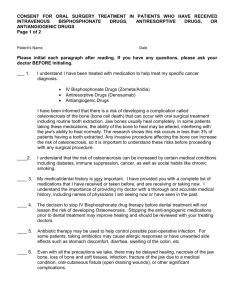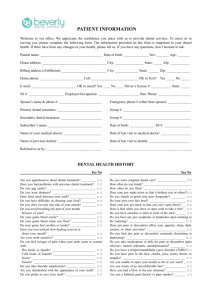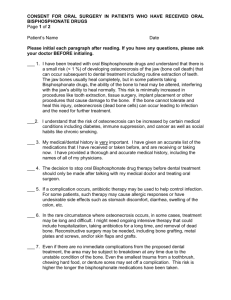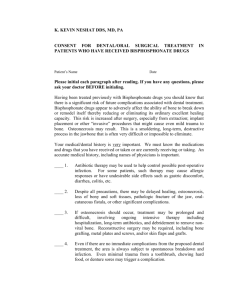הודעה על החמרה ( מידע בטיחות) בעלון לצרכן
advertisement
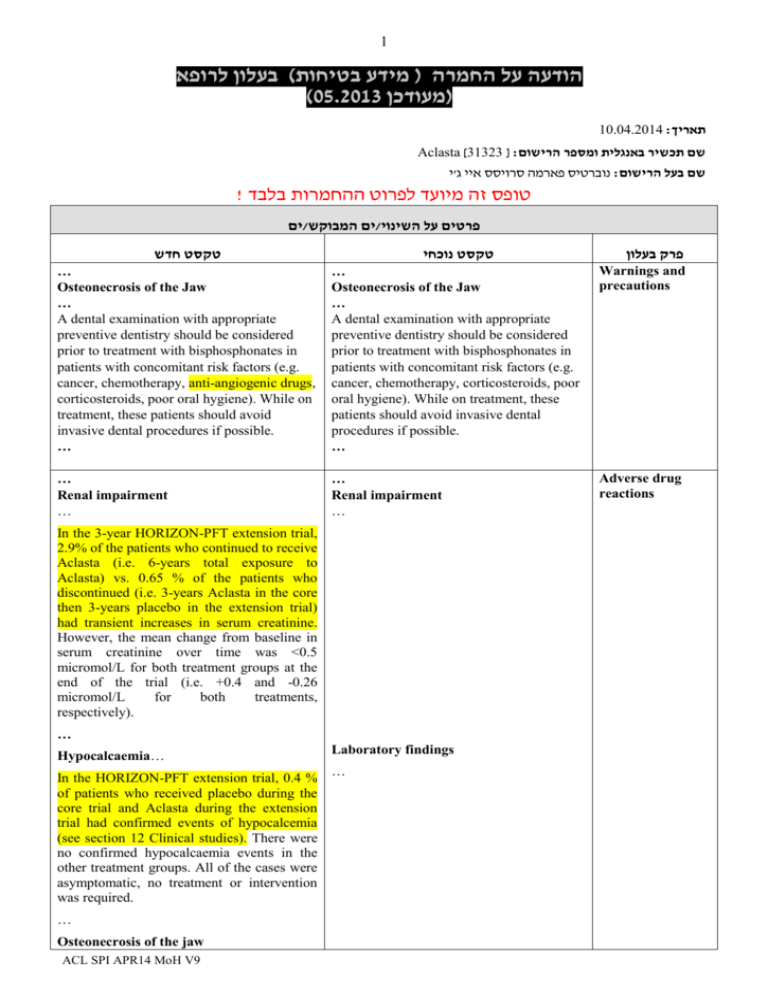
1 הודעה על החמרה ( מידע בטיחות) בעלון לרופא )05.2013 (מעודכן 10.04.2014 :תאריך Aclasta ]31323 [ :שם תכשיר באנגלית ומספר הרישום נוברטיס פארמה סרויסס איי ג'י:שם בעל הרישום ! טופס זה מיועד לפרוט ההחמרות בלבד ים/ים המבוקש/פרטים על השינוי טקסט חדש טקסט נוכחי … Osteonecrosis of the Jaw … A dental examination with appropriate preventive dentistry should be considered prior to treatment with bisphosphonates in patients with concomitant risk factors (e.g. cancer, chemotherapy, anti-angiogenic drugs, corticosteroids, poor oral hygiene). While on treatment, these patients should avoid invasive dental procedures if possible. … … Osteonecrosis of the Jaw … A dental examination with appropriate preventive dentistry should be considered prior to treatment with bisphosphonates in patients with concomitant risk factors (e.g. cancer, chemotherapy, corticosteroids, poor oral hygiene). While on treatment, these patients should avoid invasive dental procedures if possible. … Warnings and precautions … Renal impairment … … Renal impairment … Adverse drug reactions In the 3-year HORIZON-PFT extension trial, 2.9% of the patients who continued to receive Aclasta (i.e. 6-years total exposure to Aclasta) vs. 0.65 % of the patients who discontinued (i.e. 3-years Aclasta in the core then 3-years placebo in the extension trial) had transient increases in serum creatinine. However, the mean change from baseline in serum creatinine over time was <0.5 micromol/L for both treatment groups at the end of the trial (i.e. +0.4 and -0.26 micromol/L for both treatments, respectively). … Hypocalcaemia… In the HORIZON-PFT extension trial, 0.4 % of patients who received placebo during the core trial and Aclasta during the extension trial had confirmed events of hypocalcemia (see section 12 Clinical studies). There were no confirmed hypocalcaemia events in the other treatment groups. All of the cases were asymptomatic, no treatment or intervention was required. … Osteonecrosis of the jaw ACL SPI APR14 MoH V9 Laboratory findings … פרק בעלון 2 … … Osteonecrosis of the jaw (ONJ) has multiple well documented risk factors including a diagnosis of cancer, concomitant therapies (e.g. chemotherapy, anti-angiogenic drugs, radiotherapy, corticosteroids) and co-morbid conditions (e.g. anaemia, coagulopathies, infection, pre-existing dental disease). Osteonecrosis of the jaw … Osteonecrosis of the jaw (ONJ) has multiple well documented risk factors including a diagnosis of cancer, concomitant therapies (e.g. chemotherapy, radiotherapy, corticosteroids) and co-morbid conditions … (e.g. anaemia, coagulopathies, infection, In the HORIZON-PFT extension trial in pre-existing dental disease). 2,456 ITT patients, there were two confirmed … cases of ONJ, one in the group of patients receiving Aclasta during the core and the extension trial (i.e. 6-years total exposure to Aclasta) and one in the group of patients receiving placebo in the core and Aclasta in the extension trial (i.e. 3-years exposure to Aclasta). Both patients had a history of poor dental hygiene and both made a complete recovery. … Atrial fibrillation … In the HORIZON-PFT extension trial, the incidence of atrial fibrillation adverse events was 3.4% (21 out of 613) in the group of patients who received Aclasta in the core and extension trial (i.e. 6-years of total exposure to Aclasta) vs. 2.1% (13 out of 616) in patients who received Aclasta in the core (i.e. 3-years exposure) and placebo in the extension trial. The rate of atrial fibrillation serious adverse events was 2% (12 out of 613) in patients who received 6-years Aclasta compared with 1.1% (7 out of 616) in patients who received 3-years Aclasta then 3years placebo. These imbalances were not statistically significant. Adverse drug reactions from marketing spontaneous reports post- The following adverse drug reactions have been derived from post-marketing experience with Aclasta via spontaneous case reports and literature cases. Because these reactions are reported voluntarily from a population of uncertain size, it is not possible to reliably estimate their frequency which is therefore categorized as not known. Adverse drug reactions are listed according to system organ classes in MedDRA. Within each system organ class, ADRs are presented in order of decreasing seriousness. ACL SPI APR14 MoH V9 Adverse drug reactions from marketing spontaneous reports post- The following adverse reactions have been reported during post-approval use of Aclasta. Because these reports are from a population of uncertain size and are subject to confounding factors, it is not possible to reliably estimate their frequency or establish a causal relationship to drug exposure. 3 Eye disorders: scleritis, parophthalmia Immune system disorders: hypersensitivity reactions including anaphylactic reaction, anaphylactic shock, angioedema, bronchospasm, urticaria Hypersensitivity reactions including rare cases of bronchoconstriction, urticaria and angioedema, and very rare cases of anaphylactic reaction/shock have been Metabolism and nutrition disorders: reported. dehydration secondary to post-dose Rare cases of renal impairment including symptoms such as pyrexia, vomiting and renal failure requiring dialysis or with a diarrhea; hypotension in patients with fatal outcome, especially in patients with underlying risk factors pre-existing renal compromise or other risk Musculoskeletal and connective tissue factors such as advanced age, concomitant disorders: osteonecrosis of jaw (see section nephrotoxic medicinal products, 6 Warnings & Precautions) concomitant diuretic therapy, or dehydration Renal and urinary disorders: renal failure in the post infusion period have been requiring dialysis or with fatal outcome*, reported. renal impairment (see section 6 Warnings & In very rare cases, the following events have Precautions) been reported: dehydration secondary to *especially in patients with pre-existing post-dose symptoms such as fever, vomiting renal compromise or other risk factors such and diarrhea; hypotension in patients with as advanced age, concomitant nephrotoxic underlying risk factors; osteonecrosis of the medicinal products, concomitant diuretic jaw; scleritis and orbital inflammation. therapy, or dehydration in the post infusion period. Women of child-bearing potential Women of child-bearing potential should be advised to avoid becoming pregnant while receiving Aclasta. There is a theoretical risk of fetal harm (e.g. skeletal and other abnormalities) if a woman becomes pregnant while receiving bisphosphonate therapy …. Women of childbearing potential, pregnancy, breast-feeding and fertility Fertility The fertility was decreased in rats dosed subcutaneously with 0.1 mg/kg/day of zoledronic acid. There are no data available in humans . שבו מסומנות ההחמרות המבוקשות על רקע צהוב,מצ"ב העלון . יש לסמן רק תוכן מהותי ולא שינויים במיקום הטקסט.שינויים שאינם בגדר החמרות סומנו (בעלון) בצבע שונה ................הועבר בדואר אלקטרוני בתאריך ACL SPI APR14 MoH V9
